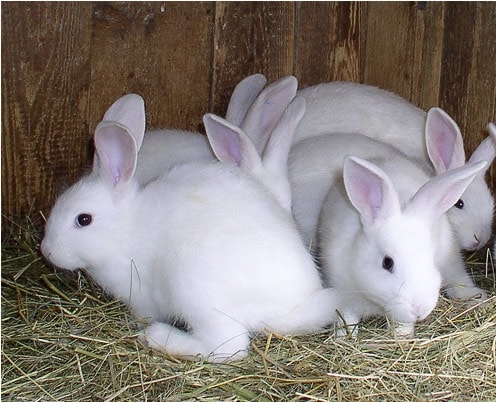Type the name of the breed you're looking for below
[wpdreams_ajaxsearchlite] Don't see the breed your're looking for? Click here and let us know!
Breed Characteristics
1 paw - breed exhibits the least amount of this characteristic
5 paws - breed exhibits most amount of this characteristic
Florida White rabbit
| Origin | The Florida White can be summed up in the word “all purpose.” In fact, the breed slogan is the “Little white rabbit that fills so many needs.” No, it’s not especially large or small. No, it doesn’t have a several-century heritage or a remarkable story behind its development. It certainly doesn’t come in varied and intriguing colors patterns! But if you’re interested in utility, this might be the breed for you. Really the Florida White has a lot going for it. As the trend in America toward “self-sustainability in small spaces” continues, the breed might gain an even larger following. As a meat animal, the Florida White is solidly built, packing 5 pounds of bunny on to a lightweight frame. Its dress out percentage is tough to beat. Litter size is usually 6 to 8 kits, in comparison to the 8 to 12 of a Californian or New Zealand. With smaller litters, the Florida is an excellent choice for a small family looking to supply the table, because they can keep the does in production but not produce more meat than they will use. The white fur of this breed not only makes the pelt more useful, but the meat from a white rabbit will actually be lighter and more attractive than meat from a dark coloured one. Florida Whites are also used in laboratories. More than anything else, perhaps, the Florida White is a prime show animal. Breeding ruby-eyed white to ruby-eyed white yields white, no exceptions. So you can concentrate on perfecting type and fur without worrying about unshowable varieties. As a result, Florida usually have beautiful body type and often take BIS honors, even three times at ARBA national conventions. The breed has cobby compact type, something like a mini New Zealand, with ear and head to balance. Florida Whites have flyback coats set in tight, sleek pelts. Judge Orville Miliken had all these purposes in mind when he developed this breed in the 1960’s. By careful matings of an albino Dutch, REW Polish, and a white New Zealand he produced a new breed which he named after his home state. It was accepted by the ARBA in 1967 and only ten years later won its first BIS at an ARBA Convention. The exhibitor was Dale Allison. One of the most famous Florida White breeders of all time was judge Eabert “Fibber” MacGehee. If you would like to give this little white rabbit a try and locate a breeder near you, members and officers of the Florida White Rabbit Breeders Association can probably help you out. |
Physical Attributes
| Weight | 4 - 6 lbs. (1.8 - 2.7 kg) |
| Ear Type | Erect |
| Fur Type | Flyback |
| Colours | White |
| Appearance | Short rounded body, rounded head and short erect ears. They are white with ruby (pink) eyes. |
| Other Considerations | Life Expectancy: 5-8 years Temperament: Gentle |
| Best Kept In | Pen. Cage or Yard. |



